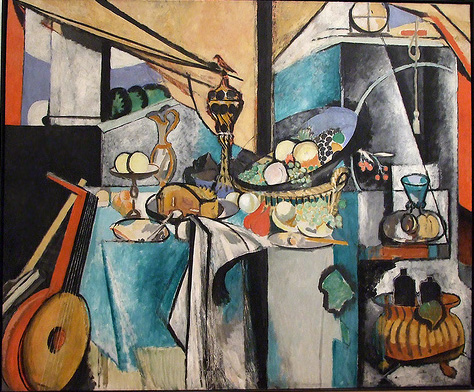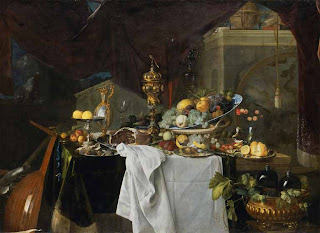Thursday, July 15th, 2010
Matisse as de Heem (or "The Old as New")
About a week ago, my brother-in-law asked if I knew of any 20th century still-life paintings which “quoted” or were influenced by a still-life from an earlier century. In essence, N was interested in seeing if any 20th century artists had abstracted a traditional still-life beyond recognition. I didn’t know of any direct copies/abstractions off the top of my head, but I did come across one example today (thanks to J!). Below is a painting by Matisse, which was influenced by the 17th century painting A Table of Dessert (“La Desserte”, 1640, shown on bottom).
Matisse, Still Life After Jan Davidsz. de Heem’s ‘La Desserte’, 1915
Jan Davidsz. de Heem, Table of Desserts (“La Desserte”), 1640
Matisse actually painted his version of this still-life after an academic copy that he made in 1893. I read a little about this painting in this article about a new Matisse exhibition at the MOMA. Looks like a fun show.
Although this isn’t exactly what my brother-in-law was looking for (Matisse didn’t abstract de Heem’s still-life beyond recognition), it still is pretty fun. That being said – does anyone know of examples in which a 20th century painter abstracted an earlier work of art beyond recognition?


The one that always sticks in my head is Dali's 'The Ghost of Vermeer of Delft Which Can Be Used As A Table'. Dali was enraptured by Vermeer, and this was his tribute to 'The Art of Painting'
Picasso of course also quoted Raphael's 'Fire in The Borgo' as a direct inspiration for his 'Guernica'
H Niyazi
threepipeproblem.blogspot.com
That is a really fun painting to look at. As always, you expand my knowledge and make it so interesting.
I actually wasn't familiar with that Dali painting, H Niyazi. It's quite fun. I'm going to remember that one. The Borgo reference in Guernica is fun, too. I like that Picasso made such a direct, obvious reference to earlier art.
e: I also think the paintings are fun to look at. It's fun to see them side-by-side and compare how Matisse treated/abstracted the original subject matter.
My daughter and I found this posting when google-searching for a different Matisse still life. We spent a delightful 30-45 minutes exploring/discussing the interplay of each still life separately and in relation to each other. Why did Matisse turn the lute forward? Introduce the diagonal that begins in the upper right quadrant? Was it to imply/anchor the triangle suggested by the arrangement of circles and ovals? And how frustrating to be looking at computer images and not originals!
As I said, a delightful conversation. Thank you for the post. I’m bookmarking this blog as one to follow.
Thanks for your comment, H Benet! I’m thrilled to know that this post sparked some discussion about art between you and your daughter. Isn’t it fun to compare these two paintings?
Welcome to my blog!